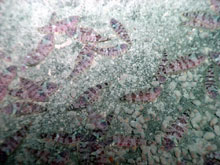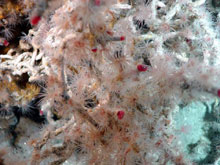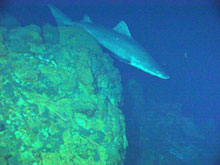
Flatfish (sole) were found in great numbers at Kasuga-1 and Daikoku volcanoes. Most of the fish in this image are < 10 cm (~4 in) long. Click image for larger view.
Kasuga-2 and Daikoku Volcanoes
April 15, 2004
Kim Juniper
Biologist
University of Quebec, Montreal
Bill Chadwick
Geologist
CIMRS Program, Oregon State University
NOAA Vents Program, Pacific Marine Environmental Laboratory
After leaving NW Eifuku Volcano, we had very little time remaining in our expedition. Due to the close proximity of Kasuga-2 and Daikoku submarine volcanoes, we were able to make one dive at each site. What struck us at both volcanoes was that warm water was leaking out over large areas of sandy sediments near their summits. Of particular interest was a small flatfish (sole) we found in great abundance in the diffuse venting areas at both Kasuga-2 and Daikoku. There are probably no other known vent areas in the world where fish are the dominant consumer organism. This fish may not be a vent specialist, but we only saw it at vent areas on these two volcanoes. It is curious that this flatfish was not observed at NW Eifuku, even though it is located between Kasuga-2 and Daikoku. These two volcanoes were also the only sites where we observed the tubeworm Lamelli brachia, which is known from other vents in the southwest Pacific.
The tubeworms were barely present at Kasuga-2 (only one small patch was found), whereas at Daikoku they were widespread, bigger in size, and their tubes were colonized by anemones and bacterial mats. The type of venting and the nature of the sea floor are probably important factors in determining which organisms dominate a particular site. Once again, the Mariana Arc volcanoes surprised us with a different type of assemblage. It is possible that the depth of NW Eifuku, over 1,000 m (about one-half mile) deeper than other sites visited on this expedition, forms a barrier to colonization by common species seen elsewhere.
Sign up for the Ocean Explorer E-mail Update List.





























